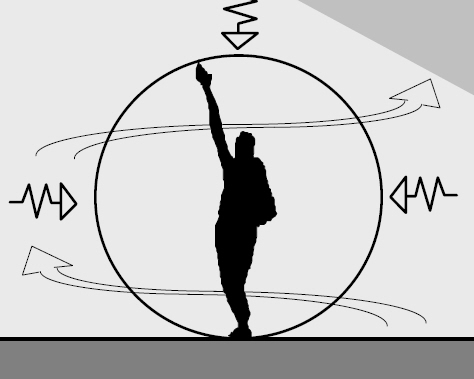Environment
Contents |
[edit] Introduction
In its broadest sense, the term ‘environment’ refers to all of the things around us. These things can affect our comfort, wellbeing, performance, behaviour, growth and development. In turn, our behaviour can impact on the environment around us.
In a very general way, the environment can be considered to comprise:
- The natural environment.
- The built environment.
[edit] The natural environment
The term 'natural environment' refers to the non-human-made surroundings and conditions in which all living and non-living things exist. The common concept of the natural environment encompasses two different components:
- Ecological units that operate as natural systems (such as soil, vegetation and so on).
- Universal natural resources (such as air and water).
In this sense, the term ‘environmental’ has become synonymous with ‘sustainability’ describing a desire to carry out activities without depleting resources or having harmful impacts, defined by the Brundtland Commission as 'meeting the needs of the present without compromising the ability of future generations to meet their own needs.' (ref. Brundtland Commission, Our Common Future, 1987).
For more information see: Natural environment.
[edit] The built environment
The term ‘built environment’ refers to aspects of our surroundings that are built by humans. It includes not only buildings, but the human-made spaces between buildings, such as parks, and the infrastructure that supports human activity such as transportation networks, utilities networks, flood defences, telecommunications, and so on.
The built environment is increasingly developed in a way that considers both its resilience to and its impact on the natural environment.
For more information see: Built environment.
[edit] Personal environmental conditions
The way that individuals experience the environment around them comprises a number of different characteristics, including:
- The thermal environment (air temperature, radiant temperature, air velocity and humidity).
- The visual environment (colour, views, lighting levels, glare, visual information and so on).
- The acoustic environment (sound and noise).
- Air quality (pollution, smells and so on)
- Textures.
[edit] Other classifications
Other definitions of the environment include:
- Internal environment.
- External environment.
- Historic environment.
- Ecological environment.
- Macro environment.
[edit] Business definition
The term 'environment' may also be used to describe the conditions within which a business operates. This can include the internal environment within the business itself, and the external environment outside the business that affects its activities. Typically the external environment is broken down into a micro environment and a macro environment.
The term 'environment' is also used in relation to computer coding to describe the development environment.
[edit] Related articles on Designing Buildings
- Air quality.
- Built environment.
- External environment.
- Historic environment.
- Indoor environmental quality.
- Internal environment.
- Operating environment.
- Macro environment.
- Micro environment.
- Natural environment.
- Sustainability.
- Thermal comfort.
- Thermal environment.
- Wellbeing.
- Environmental impact assessments.
Featured articles and news
Independent Building Control review panel
Five members of the newly established, Grenfell Tower Inquiry recommended, panel appointed.
ECA progress on Welsh Recharging Electrical Skills Charter
Working hard to make progress on the ‘asks’ of the Recharging Electrical Skills Charter at the Senedd in Wales.
A brief history from 1890s to 2020s.
CIOB and CORBON combine forces
To elevate professional standards in Nigeria’s construction industry.
Amendment to the GB Energy Bill welcomed by ECA
Move prevents nationally-owned energy company from investing in solar panels produced by modern slavery.
Gregor Harvie argues that AI is state-sanctioned theft of IP.
Heat pumps, vehicle chargers and heating appliances must be sold with smart functionality.
Experimental AI housing target help for councils
Experimental AI could help councils meet housing targets by digitising records.
New-style degrees set for reformed ARB accreditation
Following the ARB Tomorrow's Architects competency outcomes for Architects.
BSRIA Occupant Wellbeing survey BOW
Occupant satisfaction and wellbeing tool inc. physical environment, indoor facilities, functionality and accessibility.
Preserving, waterproofing and decorating buildings.
Many resources for visitors aswell as new features for members.
Using technology to empower communities
The Community data platform; capturing the DNA of a place and fostering participation, for better design.
Heat pump and wind turbine sound calculations for PDRs
MCS publish updated sound calculation standards for permitted development installations.
Homes England creates largest housing-led site in the North
Successful, 34 hectare land acquisition with the residential allocation now completed.
Scottish apprenticeship training proposals
General support although better accountability and transparency is sought.
The history of building regulations
A story of belated action in response to crisis.
Moisture, fire safety and emerging trends in living walls
How wet is your wall?
Current policy explained and newly published consultation by the UK and Welsh Governments.
British architecture 1919–39. Book review.
Conservation of listed prefabs in Moseley.
Energy industry calls for urgent reform.





























